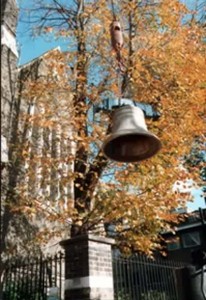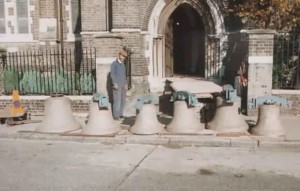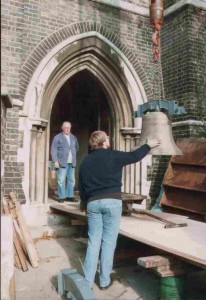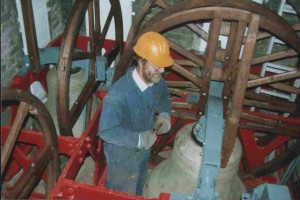| The Restoration of the spire and bells (1991-2)
The bells at Christchurch have played a unique part in the history of bellringing. On 20 July 1912 a band of eight women rang the first ever peal rung by a band of ladies. The bells were, however, unringable from 1986 when it was discovered that the spire was in a dangerous state and wobbled precariously when the bells were rung. The October 1987 hurricane brought part of the spire crashing down, as plans were being prepared to restore the tower. At first it was thought that the top 20 or 30 feet of the spire would need to be taken down, and the bells protected from all the rubble. However the parish was persuaded that it would be more sensible to remove the bells and retune and rehang them with new fittings afterwards. Together with other works to the interior of the church, the whole scheme was costed at over £150,000 and the parish set about raising the necessary funds. |
|
Ringing clergy
In 1987 the Rev. Nick Holtham arrived as Vicar. Nick had been taught to ring in Oxford by the late Frederick Sharpe, and had also rung at Enfield when a curate there. He was keen that the bells in his new parish would ring again. Nick was also joined by the Rev. Faith David (now Faith Claringbull) who had rung with the DUSCR whilst a student at Durham University. This was much to the surprise of one of our volunteer helpers, Hilary Small from Camberwell, who had been at Durham at the same time. Both met for the first time in a number of years, one Saturday lunchtime, during a break in bell-frame painting. Christchurch therefore had two ringing clergy, perhaps one of very few such parishes in the country and it was appropriate that, with the ladies’ peal connection, one of these was a woman.
The removal of the bells
Various parts of the restoration were completed as funds were raised, first the heating, then the organ, lastly the spire and bells. We were fortunate that the London Borough of Tower Hamlets historic buildings budget had £8,000 to spend at the end of the 1990/91 financial year and we were offered this money if we could spend it quickly. This was an offer too good to be refused. It provided a one-third deposit for the work to the bells, and also froze the price for the next 12 months.
A few months after completing the first stage of the Bermondsey project and whilst busy training the new band there, the removal of the eight bells from the Isle of Dogs was set for May 1991. With help from the Middlesex County Association & London Diocesan Guild of Bellringers, we had assembled a team of volunteers who by now had considerable experience in removing bells from towers, not only at Bermondsey but also the redundant churches of St. Stephen’s, Ealing and St. Paul’s, Homerton.
This project, we thought, would be much more straightforward and we lowered the front six ourselves without any professional assistance. However the bells had been augmented to eight in 1907 and the new frame partly obstructed the hatchway. After a day of experimentation, it was felt too risky to attempt lowering the tenor on its side and Phil Jakeman of Whitechapel was called in. To the disbelief of Roger Bailey and Martin Sutcliffe who had spent a day in vain, Phil soon had both tenor and seventh out of the tower.
The steeplejacks then started work, erecting scaffolding inside the spire, taking down the uppermost, part. rebuilding it and then strengthening the lower sections by lining it with an additional skin of brickwork. An old rotten floor was removed at the base of the spire, ready for a new sound control floor to be installed This was built on the steel lifting beams we had installed, prior to removing the bells.
Three months hard labour
After a brief but well earned summer holiday, our group of volunteers including Tony Faulkner and Fred Lawrence from nearby All Saints, Poplar spent many weekends wire brushing and painting the frame. With as little as 1″ clearance between the frame and walls we were tempted to leave the inaccessible parts. However, such was the enthusiasm that with the bells out of the way, the frame was partially dismantled so that all of it could be painted.
At this stage the two trebles for Bermondsey were cast and the possibility of hanging them in time for Remembrance Sunday and re-hanging the Isle of Dogs bells in time for their patronal festival seemed a possibility. Phil Jakeman would be available for a fortnight but there was a fortnight’s work for him at the Isle of Dogs alone. We were, however, by now well experienced at this type of work and there were plenty of volunteers to go round. Why not have Phil at one tower with some of us, whilst the rest were busy at the other tower.
| To hang the two treble bells at Bermondsey would involve hiring a crane as the scaffolding had long since gone. The crane could then be used to lift the Isle of Dogs bells to the top of the church steps, saving us a considerable amount of effort – brilliant!
Everything was planned like a military operation for Monday 4th November, except for one thing – we had forgotten to arrange for the side road outside Christchurch to be closed to traffic. We realised this late on the Sunday evening and some of us remembered that there were some Police “No Parking” cones near the church. At least these could be positioned to stop anyone parking in our way the next morning. |
| You could feel very conspicuous moving traffic cones at 11p.m. on a Sunday evening, especially when the local panda car happens to pass. “You might not believe this officer, but…”
Our local Police are very friendly chaps. They told us to leave the cones where they were and they would arrange for about 40 extra ones to be put out at 3 a.m. while we were home in bed. They also said it would be OK to close the road for the crane, but next time just ask! Needless to say everything else went according to plan and the Isle of Dogs try-out was arranged for Thursday 14th November. The moment of truth had arrived. A well-known guru from York Minster had once suggested that we should boil all the bells up rather than rehang them. The bells had not enjoyed the reputation of being the most tuneful of rings. It was a very great surprise to us therefore to find that sandblasting and tuning had produced an excellent result. |
| The tenor had shrunk from 12-1-4 to 10-3-27, but if it was not for the inscriptions, many of us would have sworn that they were a completely different peal.The new sound control system worked well, the sound being forced up into the spire and out through its windows and producing a well balanced effect.
Over the next ten days we finished the job off properly by redecorating the ringing room, installing new lighting and a fitted carpet. The Bishop of London, the Rt. Rev. David Hope dedicated the bells at a packed service on the morning of Sunday 24th November, attended by representatives of the Middlesex C.A. & London D.G., the London County Association and the Ladies Guild. |
The local band
It would have been simple to establish an arrangement whereby the band at Bermondsey or at nearby All Saints, Poplar rang the bells. However the decision was taken to establish a new local band with its own separate identity. All three towers also combined forces to hold several Saturday training sessions and to ring quarter peals.
When one of the new isle of Dogs ringers, Graham Bowden-Peters said that his son would be christened on Sunday 3rd May 1992 this seemed a good opportunity for the first peal since rehanging:
Middlesex CA & London DG and London County Association
ISLE OF DOGS, London E14, Christchurch
Sunday, May 3, 1992, 2h58 (11)
5088 Lincolnshire S. Major
Comp. William Barton
| 1 Robert A. Lewis | 5 Iona A E McLachlan |
| 2 Alison L Edmonds | 6 Garry S Barr |
| 3 Ruth M Foreman | 7 Anthony M Faulkner |
| 4 Richard M Hobbs | 8 Roger G Booth (C) |
First Lincolnshire: 2, 5, 6 and first in the method as conductor. Rung immediately after the christening of Frederick James Arthur Bowden-Peters.
Because the Isle of Dogs is located on the borders of a number of different ringing Associations, most of the people involved with the re-hanging of the bells and training of the new band did not belong to the same Association. There was no single Association to which all the band belonged. The band also wished to associate the peal with Nick Jones and Hilary Small who both spent many hours working on the project, but who were unable to ring.
Article by Roger Booth




